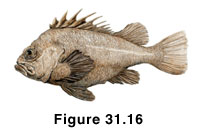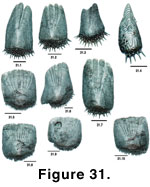 Description
DescriptionSebastes auriculatus (Brown
Rockfish)
(Other common names: Brown Rock Cod, Snapper, Bass)
Figure 31.16
 Description
DescriptionLength: 55 cm.
Mouth: large, terminal, lower jaw projects slightly; upper jaw extends past posterior margin of orbit;
Body: head spines well developed and strong (especially coronal); nuchals (reduced or absent) and suboculars absent; spine on lower gill cover edge; flat interobital space; caudal fin rounded.
Color: light brown mottled with darker brown; vertical brown bars on back and operculum; fins are dusky pink.
Depth: up to 128 m.
Habitat: rocky substrate and kelp beds; juveniles in nearshore bays and piers 10 to 30 m; adults in shallow bays and offshore to depths of 128 m; generally sedentary.
Season: ovoviparous; fertilization in the spring; larvae released in late spring to mid-summer.
Diet: polychates, crustaceans, and smaller forage fish.
Predators: lingcod (Kramer and O'Connell, 1995).
Distribution: Baja, California to southeast Alaska.
 Scale
Description
Scale
DescriptionRelative Scale Size: moderate but variable.
Position of Scales on Body: 45-52 diagonal rows below lateral line canal (Hart, 1973).
Overall Shape: square to slightly rectangular. Smaller scales are generally more rectangular than the larger scales. In some scales, the anterior field is slightly convex. Some leading edges of the lateral fields can be slightly wavy, making the lateral field appear to slightly bulge.
Focus and Circuli: the focus abuts the edge of the posterior field, along the edge of ctenii growth. The focus is approximately one-quarter of the total scale length from the outside edge of the posterior margin. The circuli are continuous between the lateral and anterior fields (except broken by radii).
Radii: numbers are variable and not diagnostic. Present only in the anterior field. The outer edge of the anterior field is generally straight to slightly convex and is scalloped.